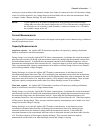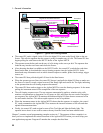
General Information - 1
19
The following events can be used to trigger critical measurements:
Change in voltage
(∆
∆∆
∆V)
If the trigger is ∆
∆∆
∆V, a data log record will be written to the buffer when a user-
specified voltage change is exceeded. If ∆V is set to 100 mV, then each time the
voltage reading changes by more than 100 mV from the last logged entry, a
record is written to the buffer.
Change in current
(∆
∆∆
∆I)
If the trigger is ∆
∆∆
∆I, a data log record will be written to the buffer when a user-
specified current change is exceeded. If ∆I is set to 100 mA, then each time the
current reading changes by more than 100 mA from the last logged entry, a
record is written to the buffer.
Change in time
(∆
∆∆
∆t)
If the trigger is ∆
∆∆
∆t, a data log record will be written to the buffer when a user-
specified time interval is exceeded. If ∆t is set to 1 second, then every second a
record is written to the buffer. ∆t is effectively a clock-driven data log.
The acceptable range of values for ∆V, ∆I and ∆t are 0 to infinity. Setting the value to 0 or near 0 will
cause all readings to be logged in the buffer, because every reading will exceed the ∆V, ∆I or ∆t value of
zero. This will fill up the measurement log very quickly. Setting the value to a high number or to infinity
will cause no readings to be logged in the buffer because no reading will exceed the ∆V, ∆I or ∆t value.
The comparison test to see if any of the ∆V, ∆I, and ∆t values have exceeded the values of the last logged
entry in the buffer is done at the end of each measurement interval. Therefore, the fastest rate at which
records can be written into the data buffer is the measurement rate of the Agilent MCCD. Any
combination of events can be specified, so that a data log record is written into the data buffer when any
of the events occur.
Each record in the data buffer contains the following information: status (including CV/CC and step
number), elapsed time, voltage, current, amp-hours, and watt-hours. The total number of readings that
can be stored is given in the specification table. The data log is a circular queue, which lets you
continuously log data into the data buffer. When the data buffer is full, the oldest data in the buffer will
be overwritten by new data. To avoid data loss, the controller must read the data from the buffer before it
is overwritten. Data can be read out of the data buffer at any time during the test sequence.
NOTE: Information in the data buffer is lost when an ac power failure occurs. To prevent data
loss in the event of a power failure, use the cfShutdown function to save the data in non-
volatile memory. Refer to Power Fail Operation in chapter 5 for more information. To
allow the Agilent E4370A to ride through temporary ac power interruptions, connect the
mainframe to a 600 VA uninterruptible power supply (UPS).
A measurement log utility is included in the software that is provided with the Agilent E4373A
Documentation package. You can use this utility to read the data log and place the information in a file
on your PC. See chapter 4 for information on how to use the Agilent MCCD Measurement Log Utility.
Protection Features
The Agilent MCCD provides extensive capability to protect both the hardware and the individual cells
being formed from catastrophic damage. The Agilent MCCD can also communicate its protection status
to other parts of the manufacturing system for more sophisticated forms of protection.


















